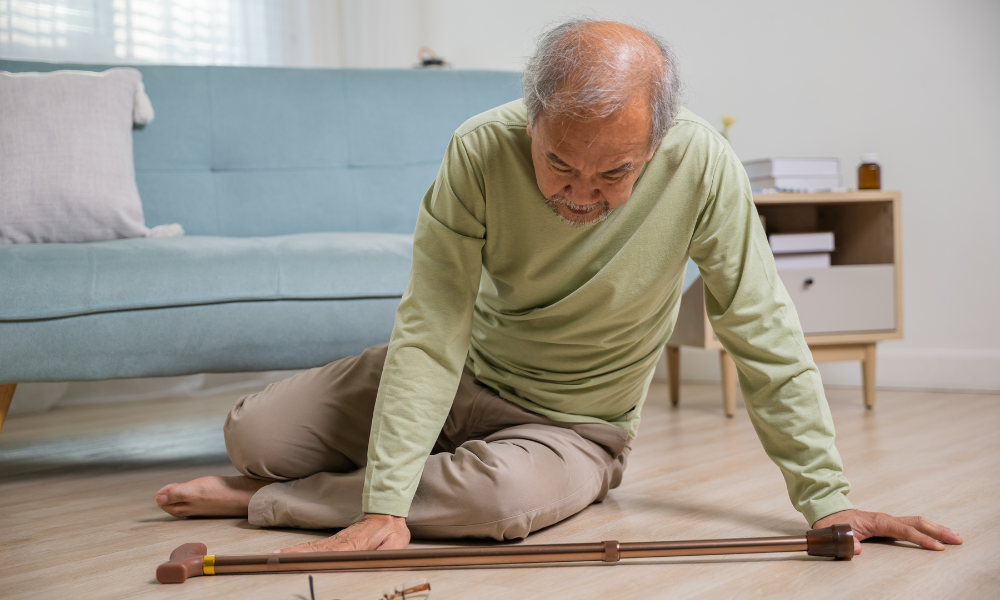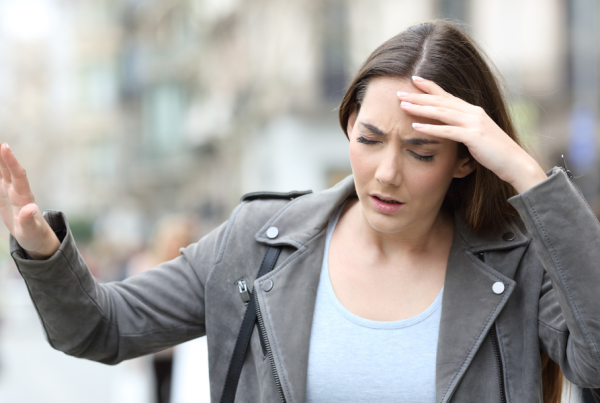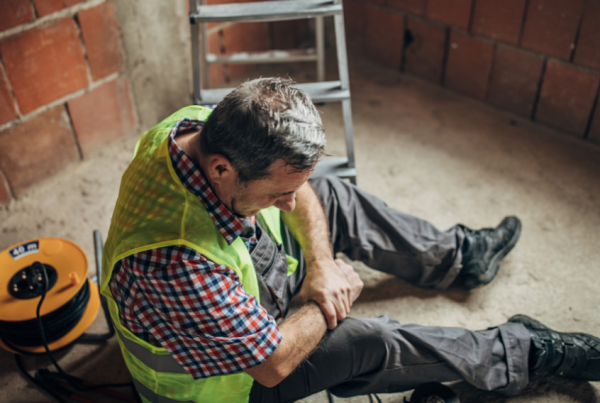Balance Issues
Move Better. Live Fuller. Your Wellness Journey Starts Here.
Schedule a FREE Discovery Call!
What Are Balance Issues?
Balance issues refer to conditions or symptoms that affect an individual’s ability to stand or move while maintaining steadiness. These problems can result in dizziness, vertigo, and other symptoms that may increase the risk of falls. Problems with balance can affect independence and an individual’s ability to participate in daily activities or tasks.
Balance can be affected by many different things. Depending on the cause of their balance problems, individuals may experience the following symptoms in addition to unsteadiness or dizziness:
- Sensations of spinning
- Lightheadedness
- Changes in vision
- Confusion

Many parts of the body contribute to balance. One of the most important components of balance is your vestibular system. This sensory system is located within the inner ear. It supplies very important information to the brain—not just about your movement, but also your head position and spatial orientation. This information is processed by the brain, along with visual information from your eyes and sensory information from your muscles or joints.
All of these inputs allow you to maintain balance. This information, combined with some impressive reflexes, allows you to not just move in general, but move while looking at something, move quickly without falling, or maintain steadiness while walking over uneven terrain. Even just standing on one leg requires work from your brain and vestibular system.
Unfortunately, there are problems that can occur with any of these systems—your vestibular system, nervous system, or musculoskeletal system—that can alter your balance. Most commonly, these problems involve the vestibular system. However, there are many different factors or conditions that may impact your balance, which we’ll discuss more next!
What Causes Balance Issues?
Problems with balance can arise from many different causes involving many different parts of the body. We’ve outlined some common examples below, organized by type:
Vestibular Conditions
These conditions are specific to the vestibular system, typically involving a variety of structures within the inner ear. Problems with this system can create balance issues and dysfunction in a few different ways, such as the following:
- Benign paroxysmal positional vertigo (BPPV): A common cause of vertigo that often occurs with sudden head movements. These movements can disrupt the position of calcium carbonate crystals in the inner ear, which play a role in balance.
- Meniere’s disease: A long-term inner ear disorder with unknown causes. Typically causes dizzy spells, hearing loss, and other symptoms.
- Vestibular hypofunction: Dysfunction of the inner ear that prevents proper balance and function. It can be caused by damage, medications, disorders, and more.
Neurological Causes
Each of these causes involve either damage or underdevelopment of parts of the body that affect balance; particularly the brain, spinal cord, or nerves, which are needed to receive sensory inputs that allow for balance.
- Parkinson’s disease: The effects of Parkinson’s disease can make it difficult for the brain to adjust to movements quickly, affecting balance, gait, and the ability to catch oneself during a fall.
- Multiple sclerosis (MS): MS can cause problems with nerve fibers that are needed to help the brain communicate with other parts of the body, which can affect coordination and movement.
- Stroke: Stroke can cause damage to some areas of the brain that are necessary for processing sensory inputs.
- Cerebral palsy: This condition can cause a range of mobility limitations and involuntary movements that affect gait and balance.
- Spina bifida: Spina bifida can affect the development of the spine and spinal cord, which are responsible for sending information throughout the body. This condition may affect development of the brain, bones, or other structures, many of which may contribute to mobility problems caused by poor muscle control or joint function.
- Peripheral neuropathy: Refers to conditions that affect the nerves outside of the brain and spinal cord, which can alter muscle function and sensation—which in turn can affect the body’s ability to detect position.
- Cerebellar disorders: This refers to conditions that affect the cerebellum, a part of the brain responsible for balance and coordination. This can include cancer, degeneration, genetic causes, and more.
Musculoskeletal Causes
These causes refer to conditions, injuries, or problems that occur to the bones, muscles, ligaments, or tendons of the body. When there is dysfunction in any of these structures, it can become more difficult to move freely, function (walk, climb, pick up items), and catch oneself in the case of a fall.
- Arthritis: Refers to conditions of the joints that cause weakness, pain, inflammation, and stiffness.
- Muscle weakness: Muscle weakness can be caused by a variety of things (injury, surgery, sedentary lifestyle, etc.) and can contribute to lowered stability. Weakened muscles can make it more difficult to catch oneself during a fall and increase the risk of injury.
- Gait abnormalities: Problems with walking patterns are often accompanied by problems with balance and stability, as it may affect posture and the body’s weight distribution. Gait can be altered by injury, neurological disorders, nerve damage, and more.
- Sports injuries: Sports-related injuries can range widely and may affect the body physically or neurologically. Depending on the type, severity, and recovery of the injury, it may affect a person’s balance, mobility, and coordination.
- Joint instability or pain: Problems with the joints can have similar effects as muscle weakness—causing lessened stability, impaired mobility, and a worsened ability to catch oneself in the event of a fall. For those who have replacement surgeries, removed joint tissue can affect proprioception.
- Age-related sarcopenia: This refers to a decline in muscle mass with age, which can contribute to muscle weakness and increases the risk of falls or injury. While aging is unavoidable, this condition can be worsened or become more likely due to poor diet and an inactive lifestyle.
Physical Therapy for Balance Issues
Physical therapy plays an important role in managing balance problems or conditions. It can improve mobility, lower fall risk, and enhance stability through curated treatments. Physical therapists are able to provide valuable education and strategies to better manage symptoms at home and in daily life.
Balance struggles can look different for everyone as they originate from different causes. Your physical therapist will be sure to perform a thorough examination and evaluation that will help them understand the causes of your symptoms, and formulate a specialized plan of care based on your unique needs.
This evaluation and examination process may include:
- An exploration of your symptoms: Dizziness, vertigo, vision problems, falls, etc.
- A review of any pre-existing conditions or medications that may impact balance.
- Functional tests to observe your ability to walk, climb stairs, bend over, or perform other tasks.
- An observation of your standing or walking posture and gait.
- Physical examinations or tests to look for muscle weakness, joint instability, inflexibility, incoordination, or a loss of proprioception.
- Specialized tests to evaluate your ability to move or stand still within certain circumstances, as well as your general ability to maintain balance.
- A discussion of your home or work environment to identify any harmful environmental factors that may contribute to difficulties with balance.
Once your physical therapist has a better understanding of your potential causes and contributors to balance problems, they’ll begin leading you through a variety of treatments involving strengthening exercises, functional training, stretching, and more. We’ve outlined these treatments in more detail below:
Vestibular Rehabilitation
Vestibular rehabilitation refers to activities or exercises that are designed to address dysfunctions of the inner ear. These activities can vary based on the condition, and may include general exercises to improve stability and reduce dizziness. Some examples include:
- Epley maneuver: Head or body movements designed to reposition the inner ear crystals that are displaced in BPPV.
- Gaze stabilization: Activities designed to improve the connection between your balance and vision, which can address dizziness and other symptoms such as nausea. These symptoms are usually experienced when an individual tries to maintain focus on a stationary or moving object, or maintain focus while their body is in motion.
- Habituation exercises: These exercises are designed to reduce dizziness that occurs as a result of changes in head position or movements. Habituation exercises reduce this dizziness through desensitization: Exposing the body to these movements to gradually reduce the effects of dizziness.
Balance and Coordination Training
Both balance and coordination can be improved with consistent practice and exercise. There are a variety of exercises that can be done to improve these factors, many of which are very simple and don’t require special equipment.
For many, working through these with a physical therapist can ensure safety and an appropriate progression of difficulty, especially for those recovering from injury or other conditions. Physical therapists can modify these exercises if they prove too challenging for you. Some examples include:
- Practicing standing on one leg at a time
- Walking heel-toe in a straight line
- Walking in figure-8 paths
- Stepping over obstacles
- Holding the tandem stance
- Yoga
- And more
Many of these exercises can be made to enhance proprioceptive and vestibular function too, by adding in challenges such as closing your eyes or walking on uneven surfaces. However, these more challenging exercises should only be done with supervision of a physical therapist to ensure safety.
Functional Training
Functional training aims to improve your daily mobility and function. This training is done by practicing these activities while modifying posture and movement mechanics as needed. These tasks will vary from person to person, and can be further improved when combined with other treatments like strengthening and stretching. Some functional training practice can include activities such as:
- Correcting gait
- Practicing daily movements like turning, bending, lifting, etc.
- Improving posture while standing or walking
- Practicing basic multi-tasking
- Learning techniques to recover from a fall
- Practice movements or activities specific to your work or home needs
Strengthening and Stretching
Improving muscle strength and overall flexibility can significantly improve a person’s stability and balance, as well as reduce the risk of injury from falls. Strength is necessary in many areas of the body to support good posture, efficient movement, and the ability to catch oneself in the event of a fall.
Therefore, your physical therapist will look to improve any weakened muscle groups, particularly those of the core, legs, hips, or back. They’ll want to improve your flexibility as well as the range of motion of your joints and other areas that play a role in supporting movement and balance.
Your physical therapist may lead you through specific activities to improve the function and coordination of all these muscle groups. This can include tasks like climbing stairs, moving from sitting to standing, and more.
Manual Therapy
Manual therapy refers to hands-on treatments that manipulate and mobilize muscles, joints, nerves, tendons, and other underlying structures. These treatments improve your range of motion and muscle function, and can address any symptoms of pain. They can address restrictive joint tissue, which can contribute to stiffness or mobility issues. Common manual therapies utilized at Hive Therapy and Wellness include hands-on techniques, tissue scraping, cupping, dry needling, and more.
Education and Home Strategies
Lastly, your physical therapist will provide you with a wealth of information, advice, and suggestions for managing your balance problems at home and in your daily life. This can include suggestions for home environment modifications to remove fall hazards or install more safety features, learning to use mobility aids properly and effectively, or the creation of a home exercise plan to maintain flexibility and strength.
The physical therapists at Hive Therapy and Wellness work hard to provide comprehensive, individualized treatment to their patients. They’re ready to listen to your unique needs and concerns involving problems with balance, and work diligently to improve your quality of life. They may use a variety of treatments to help you achieve better independence, confidence, and stability in your day to day life, such as any of the following:
- Neuromuscular re-education
- Manual therapy
- Exercise prescription
- Dry needling
- Cupping
- Tissue scraping
- Behavioral modifications
- Therapeutic activities
- Electrical muscle stimulation
- Spinal manipulation
- Therapeutic modalities
- Biofeedback
Balance issues refer to conditions or symptoms that affect an individual’s ability to stand or move while maintaining steadiness.
These problems can result in dizziness, vertigo, and other symptoms that may increase the risk of falls. Problems with balance can affect independence and an individual’s ability to participate in daily activities or tasks.
Balance can be affected by many different things. Depending on the cause of their balance problems, individuals may experience the following symptoms in addition to unsteadiness or dizziness:
- Sensations of spinning
- Lightheadedness
- Changes in vision
- Confusion
Many parts of the body contribute to balance. One of the most important components of balance is your vestibular system. This sensory system is located within the inner ear.
It supplies very important information to the brain—not just about your movement, but also your head position and spatial orientation. This information is processed by the brain, along with visual information from your eyes and sensory information from your muscles or joints.
All of these inputs allow you to maintain balance.
This information, combined with some impressive reflexes, allows you to not just move in general, but move while looking at something, move quickly without falling, or maintain steadiness while walking over uneven terrain.
Even just standing on one leg requires work from your brain and vestibular system!
Unfortunately, there are problems that can occur with any of these systems—your vestibular system, nervous system, or musculoskeletal system—that can alter your balance.
Most commonly, these problems involve the vestibular system. However, there are many different factors or conditions that may impact your balance, which we’ll discuss more next!
Problems with balance can arise from many different causes involving many different parts of the body. We’ve outlined some common examples below, organized by type:
Vestibular Conditions
These conditions are specific to the vestibular system, typically involving a variety of structures within the inner ear.
Problems with this system can create balance issues and dysfunction in a few different ways, such as the following:
- Benign paroxysmal positional vertigo (BPPV): A common cause of vertigo that often occurs with sudden head movements. These movements can disrupt the position of calcium carbonate crystals in the inner ear, which play a role in balance.
- Meniere’s disease: A long-term inner ear disorder with unknown causes. Typically causes dizzy spells, hearing loss, and other symptoms.
- Vestibular hypofunction: Dysfunction of the inner ear that prevents proper balance and function. It can be caused by damage, medications, disorders, and more.
Neurological Causes
Each of these causes involve either damage or underdevelopment of parts of the body that affect balance; particularly the brain, spinal cord, or nerves, which are needed to receive sensory inputs that allow for balance.
- Parkinson’s disease: The effects of Parkinson’s disease can make it difficult for the brain to adjust to movements quickly, affecting balance, gait, and the ability to catch oneself during a fall.
- Multiple sclerosis (MS): MS can cause problems with nerve fibers that are needed to help the brain communicate with other parts of the body, which can affect coordination and movement.
- Stroke: Stroke can cause damage to some areas of the brain that are necessary for processing sensory inputs.
- Cerebral palsy: This condition can cause a range of mobility limitations and involuntary movements that affect gait and balance.
- Spina bifida: Spina bifida can affect the development of the spine and spinal cord, which are responsible for sending information throughout the body. This condition may affect development of the brain, bones, or other structures, many of which may contribute to mobility problems caused by poor muscle control or joint function.
- Peripheral neuropathy: Refers to conditions that affect the nerves outside of the brain and spinal cord, which can alter muscle function and sensation—which in turn can affect the body’s ability to detect position.
- Cerebellar disorders: This refers to conditions that affect the cerebellum, a part of the brain responsible for balance and coordination. This can include cancer, degeneration, genetic causes, and more.
Musculoskeletal Causes
These causes refer to conditions, injuries, or problems that occur to the bones, muscles, ligaments, or tendons of the body.
When there is dysfunction in any of these structures, it can become more difficult to move freely, function (walk, climb, pick up items), and catch oneself in the case of a fall.
- Arthritis: Refers to conditions of the joints that cause weakness, pain, inflammation, and stiffness.
- Muscle weakness: Muscle weakness can be caused by a variety of things (injury, surgery, sedentary lifestyle, etc.) and can contribute to lowered stability. Weakened muscles can make it more difficult to catch oneself during a fall and increase the risk of injury.
- Gait abnormalities: Problems with walking patterns are often accompanied by problems with balance and stability, as it may affect posture and the body’s weight distribution. Gait can be altered by injury, neurological disorders, nerve damage, and more.
- Sports injuries: Sports-related injuries can range widely and may affect the body physically or neurologically. Depending on the type, severity, and recovery of the injury, it may affect a person’s balance, mobility, and coordination.
- Joint instability or pain: Problems with the joints can have similar effects as muscle weakness—causing lessened stability, impaired mobility, and a worsened ability to catch oneself in the event of a fall. For those who have replacement surgeries, removed joint tissue can affect proprioception.
- Age-related sarcopenia: This refers to a decline in muscle mass with age, which can contribute to muscle weakness and increases the risk of falls or injury. While aging is unavoidable, this condition can be worsened or become more likely due to poor diet and an inactive lifestyle.
Physical therapy plays an important role in managing balance problems or conditions. It can improve mobility, lower fall risk, and enhance stability through curated treatments.
Physical therapists are able to provide valuable education and strategies to better manage symptoms at home and in daily life.
Balance struggles can look different for everyone as they originate from different causes. Your physical therapist will be sure to perform a thorough examination and evaluation that will help them understand the causes of your symptoms, and formulate a specialized plan of care based on your unique needs.
This evaluation and examination process may include:
- An exploration of your symptoms: Dizziness, vertigo, vision problems, falls, etc.
- A review of any pre-existing conditions or medications that may impact balance.
- Functional tests to observe your ability to walk, climb stairs, bend over, or perform other tasks.
- An observation of your standing or walking posture and gait.
- Physical examinations or tests to look for muscle weakness, joint instability, inflexibility, incoordination, or a loss of proprioception.
- Specialized tests to evaluate your ability to move or stand still within certain circumstances, as well as your general ability to maintain balance.
- A discussion of your home or work environment to identify any harmful environmental factors that may contribute to difficulties with balance.
Once your physical therapist has a better understanding of your potential causes and contributors to balance problems, they’ll begin leading you through a variety of treatments involving strengthening exercises, functional training, stretching, and more.
We’ve outlined these treatments in more detail below:
Vestibular Rehabilitation
Vestibular rehabilitation refers to activities or exercises that are designed to address dysfunctions of the inner ear.
These activities can vary based on the condition, and may include general exercises to improve stability and reduce dizziness. Some examples include:
- Epley maneuver: Head or body movements designed to reposition the inner ear crystals that are displaced in BPPV.
- Gaze stabilization: Activities designed to improve the connection between your balance and vision, which can address dizziness and other symptoms such as nausea. These symptoms are usually experienced when an individual tries to maintain focus on a stationary or moving object, or maintain focus while their body is in motion.
- Habituation exercises: These exercises are designed to reduce dizziness that occurs as a result of changes in head position or movements. Habituation exercises reduce this dizziness through desensitization: Exposing the body to these movements to gradually reduce the effects of dizziness.
Balance and Coordination Training
Both balance and coordination can be improved with consistent practice and exercise. There are a variety of exercises that can be done to improve these factors, many of which are very simple and don’t require special equipment.
For many, working through these with a physical therapist can ensure safety and an appropriate progression of difficulty, especially for those recovering from injury or other conditions.
Physical therapists can modify these exercises if they prove too challenging for you. Some examples include:
- Practicing standing on one leg at a time
- Walking heel-toe in a straight line
- Walking in figure-8 paths
- Stepping over obstacles
- Holding the tandem stance
- Yoga
- And more
Many of these exercises can be made to enhance proprioceptive and vestibular function too, by adding in challenges such as closing your eyes or walking on uneven surfaces.
However, these more challenging exercises should only be done with supervision of a physical therapist to ensure safety.
Functional Training
Functional training aims to improve your daily mobility and function. This training is done by practicing these activities while modifying posture and movement mechanics as needed.
These tasks will vary from person to person, and can be further improved when combined with other treatments like strengthening and stretching. Some functional training practice can include activities such as:
- Correcting gait
- Practicing daily movements like turning, bending, lifting, etc.
- Improving posture while standing or walking
- Practicing basic multi-tasking
- Learning techniques to recover from a fall
- Practice movements or activities specific to your work or home needs
Strengthening and Stretching
Improving muscle strength and overall flexibility can significantly improve a person’s stability and balance, as well as reduce the risk of injury from falls.
Strength is necessary in many areas of the body to support good posture, efficient movement, and the ability to catch oneself in the event of a fall.
Therefore, your physical therapist will look to improve any weakened muscle groups, particularly those of the core, legs, hips, or back.
They’ll want to improve your flexibility as well as the range of motion of your joints and other areas that play a role in supporting movement and balance.
Your physical therapist may lead you through specific activities to improve the function and coordination of all these muscle groups.
This can include tasks like climbing stairs, moving from sitting to standing, and more.
Manual Therapy
Manual therapy refers to hands-on treatments that manipulate and mobilize muscles, joints, nerves, tendons, and other underlying structures.
These treatments improve your range of motion and muscle function, and can address any symptoms of pain.
They can address restrictive joint tissue, which can contribute to stiffness or mobility issues. Common manual therapies utilized at Hive Therapy and Wellness include hands-on techniques, tissue scraping, cupping, dry needling, and more.
Education and Home Strategies
Lastly, your physical therapist will provide you with a wealth of information, advice, and suggestions for managing your balance problems at home and in your daily life.
This can include suggestions for home environment modifications to remove fall hazards or install more safety features, learning to use mobility aids properly and effectively, or the creation of a home exercise plan to maintain flexibility and strength.
The physical therapists at Hive Therapy and Wellness work hard to provide comprehensive, individualized treatment to their patients.
They’re ready to listen to your unique needs and concerns involving problems with balance, and work diligently to improve your quality of life.
They may use a variety of treatments to help you achieve better independence, confidence, and stability in your day to day life, such as any of the following:
- Neuromuscular re-education
- Manual therapy
- Exercise prescription
- Dry needling
- Cupping
- Tissue scraping
- Behavioral modifications
- Therapeutic activities
- Electrical muscle stimulation
- Spinal manipulation
- Therapeutic modalities
- Biofeedback
You can learn more about these treatments on our Treatments Page.





